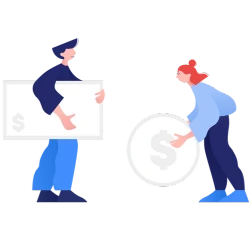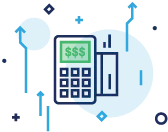TABLE OF CONTENTS
Variable recurring payments (VRPs) are rapidly gaining popularity as a flexible and secure way to facilitate payments. With research suggesting that US-based recurring payments will reach a transaction volume of more than $830 billion by 2025, many business owners want to increase their income levels with VRP.[1]Javelin Strategy. “Subscription and Recurring Payments Is a Large Market with Lots of Opportunity.” Accessed on May 1, 2025. However, while recurring payments play an integral role in many business strategies, much of the infrastructure for collecting payments is based on automatic debit transfers created decades ago.
A variable recurring payment is a new form of direct debit transfer, allowing merchants and consumers to benefit from increased payment security, flexibility, and speed. Instead of using an archaic system that withdraws the same amount on the same day each month, VRPs are adjustable and viewable within a customer’s smartphone banking app. VRPs are set to modernize how businesses accept payments, which can have a lasting impact on their success.
This guide explores variable recurring payments in their entirety, including their benefits, use cases, and other related topics. Let’s get started!
What Are Variable Recurring Payments (VRP)?

Variable recurring payments are transactions facilitated by a Payment Initiation Service Provider (PISP). Account holders can allow bank account access to a PISP to make payments on their behalf. Upon approval, payments authorize under pre-defined parameters, including a maximum payment frequency and amount. While PISPs have more access to accounts than with traditional direct debit, customers have total control of this access. An account holder can choose to revoke access from the PISP and cancel future payments anytime.
This advancement in recurring payments is only possible because of the “Open Banking” initiative seen particularly in the European Union (EU). Open Banking, a component of the EU’s PSD2 regulations, promotes using customer data for APIs, bringing a range of new banking products to the forefront of the industry.[2]European Central Bank. “The revised Payment Services Directive (PSD2) and the transition to stronger payments security“. Accessed on May 1, 2025. For example, Plaid uses customers’ account data to facilitate financial services such as ACH transfers through payment API integration. PSD2 involves strict regulations to protect account holders and ensure all parties have more control over their accounts and payments.
What Are the Benefits of VRPs?
VRP advantages are available to both parties involved in a payment. Let’s explore the upsides of this modern payment option for merchants and consumers:
For merchants
- Additional Payment Flexibility: Merchants can adjust payments routinely without having to notify the customer (provided the adjustments conform to pre-defined parameters).
- Fewer Administrative Needs: With VRPs, merchants don’t need to provide written notice to a customer to change a payment date or amount. All adjustments happen automatically as long as they fall within pre-determined limits.
- Instant Transfers: Traditional direct debits may take days to process. VRPs instantly authenticate bank details, making it faster for merchants to receive funds.
- Reduced Chargebacks: Chargebacks result in lost revenue and increased processing fees, and can have other lasting effects on businesses. However, since VRPs exist outside of credit card payments, the chargeback process doesn’t apply to them. This can significantly reduce merchants’ exposure to fraudulent chargebacks.
- Lower Transaction Costs: Bank transfers generally have lower processing fees than credit card payments. So, if a merchant is looking to save on fees, VRPs are an excellent addition.
- Happier Customers: VRPs reduce administrative hassle for customers by minimizing the effort it takes to pay bills. In turn, businesses benefit from an improved customer experience.
For consumers
- Reduced Overdraft Fees: As consumers have more control over the VRP parameters, account balances can automatically adjust to accommodate upcoming payments, reducing the need for overdraft fees.
- More Secure: Since traditional direct debit payments require bank details and a signature, the system is prone to fraudsters with access to an individual’s routing and account number. With VRPs, consumers register the payment within a banking app, making the process harder for cybercriminals.
- Additional Control and Flexibility: With traditional direct debits, money is withdrawn from a consumer’s account on the same day each month, and changes aren’t allowed unless there has been written communication. This makes it more difficult to adjust payment parameters, whereas VRPs allow for flexible payment options and adjustments.
- Viewable Within Banking Apps: Unlike direct debits, VRPs are viewable within your banking app. This makes it much simpler to manage, adjust, and cancel any existing VRPs from the comfort of your own phone. With a VRP, contacting a merchant directly to cancel a payment is unnecessary.
What Is Sweeping?
The term sweeping refers to transferring money between two linked bank accounts (usually, a customer’s checking and savings accounts). The sweeping process allows for automated transfers, reducing the need for manually transferring money to accounts with better savings rates.

What are the benefits of sweeping?
Sweeping offers various benefits to its users. Let’s explore the top two advantages below:
Protection from overdrafts
American consumers spend around $8 billion a year on overdraft fees.[3]The Ascent. “Overdraft Fees Are Costing Americans $8 Billion. Are You One of the Impacted?“. Accessed on May 1, 2025. While banks rely on these fees for revenue, they can hurt consumers. By using VRPs, consumers have increased protection from overdraft fees.
For example, if a customer’s bank account is too low, sweeping uses a VRP to automatically transfer money from a savings account to ensure the checking account has enough to cover bills and other transactions.
Not only does this help bank account holders, but it also yields merchant benefits. If a customer associates a business with overdrawing their account, it may negatively affect the business’s reputation with the customer.
Automated savings
Sweeping allows consumers to automate the savings process. For example, if an individual wants to take advantage of higher interest rates, they can request a VRP whenever their checking account exceeds a certain level.
Also, as previously stated, money can be transferred automatically from a savings account to a checking account using a VRP if the account’s balance is too low.
Distributing cash into savings accounts with higher interest rates helps businesses too. With sweeping, a business can set parameters to automatically transfer money into high-yield savings accounts, increasing cash flow without manual transfer processes.
Using VRPs for Sweeping vs Other Use Cases
While sweeping has clear benefits for consumer and commercial bank account holders, there are other proposed use cases. Let’s explore the top options in more detail below:

Utility Bills
With a traditional direct debit payment, changing the value or frequency of the payment is challenging. However, with VRPs, businesses can adjust payments according to a customer’s recent bill. For example, if the customer of an energy company receives a bill each month based on the previous month’s energy usage, the energy company can adjust the amount the customer’s bank account pays each month (as long as it conforms to the agreed-upon parameters).

Real-Time Commercial Tax Payments
Some governments are considering using VRPs for real-time commercial tax payments. For example, if a customer pays an invoice to a business, the government could use a VRP to deduct a tax payment from the total invoice. This would greatly help to reduce unpaid taxes and increase tax efficiency.

Subscription Business Flexibility
With subscription businesses usually charging a set monthly rate for services, VRPs offer a unique alternative. Subscription-based businesses using VRPs can access the payment speed of credit cards with the cost benefits of traditional money transfers. Likewise, the flexibility of VRPs allows businesses to bill customers for add-ons in real time.

Real-Time B2B Payments
VRPs make it easier for businesses that rely on traditional invoicing by helping them avoid late payments. By allowing VRPs to instantly charge clients, businesses have fewer cash flow problems and receive money for projects instantly.
What Are Commercial VRPs?
Currently, most real-life VRP examples involve “sweeping” money between two bank accounts owned by the same person. As previously discussed, this process allows account holders to automate moving money into savings accounts from checking accounts, and vice versa.
On the other hand, commercial VRPs entail opening the infrastructure up to improve the existing recurring payment options. This involves the use cases outlined in the previous section of this guide, such as real-time tax payments, utility bill payments, and more.
Although VRPs operate on a restricted basis now, the widescale adoption of commercial VRPs would revolutionize how customers pay merchants for products. In doing so, the following years would feature significant advancements in payment processing, especially for recurring payments—making the traditional direct debit system obsolete.
How to Implement VRPs in Your Business for Today & Tomorrow
While VRPs offer many opportunities for both consumers and businesses, commercial VRPs aren’t fully adopted here in the U.S. yet. In the meantime, take advantage of other credit card processing perks by partnering with an experienced merchant account provider to access some of the same benefits found in VRPs. When you apply for a merchant account with PaymentCloud, your business will be kept up to date with the latest developments in the VRP space!
Level up your business
Accepting credit cards has never been easier!
Merchant Account today
Simple
Open Banking Variable Recurring Payments: FAQs
Are VRPs secure?
VRPs are more secure than traditional direct debit payments. Direct debits rely on providing account numbers, routing numbers, and signatures for permission. With VRPs, account holders can set up payments and different parameters within their banking apps.
Will VRPs make fixed recurring payments extinct?
Currently, VRPs are only available in a few countries, meaning their full-scale adoption still has a lot of ground to cover. Although, considering how much more efficient and flexible VRPs are compared to fixed recurring payments, it’s hard to believe that this option won’t become a dominant force in the payments industry sometime soon.
Can VRPs become vulnerable to fraudulent activity?
While there’s always a chance that fraudulent activity can occur with variable recurring payments or any other type of payment, there’s no doubt that VRPs are designed to help reduce exposure to fraud. Setting up VRPs involves customers logging into their bank accounts and completing a verification process. To commit VRP fraud, a scammer would have to gain access to a customer’s bank account and overcome various security hurdles.






